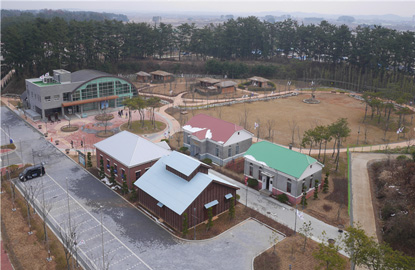Arirang Literature Village

- Address 180 with the flowering plant it is the Jeonbuk special self-governing province Gimje CITY Juksan
- Service hours Closed on January 1st every year
- Fare No charge
- Homepage http://www.gimje.go.kr
- Phone number Literature Village Management Office(063-540-2927)
Introduction of tourist site
As to 'the Jing crab' of 'jinggemaenggaengoeemit', the evening scene and 'oeemits' the Gimje and 'maeng pit' intend the wide. It is the archaic word of the Gimje evening scene plain,that is Korea representative granary zone. The which the Jinggemaeng crab is extensive was the place where the plundering was the most extreme with this reason in the period of Japanese occupation in 1900's. Because of have the large-scale representativeness representing our history through the suffering and fight which our people had to experience, Cho Jeongrae writer would choose Gimje as Baegyeongji of the period of Japanese occupation history novel. If it is the Gimje CITY Juksan, the Arirang Literature Village created in my village · Ri around town has the place which it reappears as it is in order to see the major settings appearing in the novel directly and feel.
Arirang Literature Village is composed of promotion hall, modern exploitation institute, Naechon·Oeri Village and Harbin station. On the 1st floor of promotion hall, Japanese exploitation processes and contents about Anti-Japanese Movement are clearly organized. On the 2nd floor of promotion hall, the first thing we notice is a sculpture with Arirang lyrics. In this place, there is explanation about independence fighters from Gimje. These heroes who were someone's husband, child and friend might decide to fight against the situation of unjust period in extreme exploitation life facing the fear of death for a great cause. In the opposite side of promotion hall, the modern exploitation institute is located.
Naechon·Oeri Village were created by reenacting the houses of the novel's leading characters Son Pan-seok, Ji Sam-chul, person living in Gamgol, Song Su-ik, etc. The lives of houses owners in the novel are not that peaceful like the appearance of the village. Harbin station is a place where Ahn Jung-geun assassinated Ito Hirobumi in 1909. About 60% of the actual building in 1910's is minimized and reenacted. After Ahn Jung-geun assassinated Ito Hirobumi, he exclaimed 'Korea hurrah!' in Esperanto a couple of times and captured by Russian military police. The snipe situation is recreated as it was. Also, steam locomotive of the time is recreated together, so it adds vividness. There is an immigrant house in front of Harbin station square. The shingle-roofed house and reed house, our people who left away from Japanese exploitation built, are recreated. The shingle-roofed house is like a part of minimal home, but the reed house is too bad. Like this, Arirang Literature Village is not only a vivid cultural space feeling the breathing of people but also a place of history education, where is a must for Koreans of all ages.
